Research and Innovation - International Railway Summit
After Coronavirus: An opportunity for green mobility in Europe
In March 2020, shortly before the current Coronavirus crisis, the European Commission announced that 2021 would be the “Year of Rail”, in recognition of its potential to be a driving contributor to this mandate’s commitment to achieving its hallmark objective: the EU Green Deal. Europe now finds itself dealing with the ramifications of a widespread public health emergency and its associated economic effects, and rail will be part of the Union’s future recovery and allow it to continue on track towards carbon neutrality. To do so, it is essential that decision-makers at the EU and National levels remain committed to implementing smart, sustainable rail solutions and investing in the development of green technologies that enable them.
The success of any solution relies on its popularity and mobility options are no exception. In recent years, society and individual customers have become increasingly aware of the growing threat of climate change and now seek environmentally friendly solutions. The railway sector needs to continue to prioritise offerings that cater seamlessly to multimodal end-user needs. Providing passengers and freight end-users with more expansive rail mobility services and fostering widespread adoption of digital solutions will be key to creating a future sustainable transport paradigm. The fact that these preconditions must be enacted to create a greener network was given voice by European Commissioner for Transport Adina-Ioana Vălean at the 2020 European Rail Award when she explained that “decarbonizing transport will depend strongly on rail increasing its market share”.
To encourage customers to shift to rail, it is important that rail gives them the tools to tailor it to their needs. Fortunately, our sector is already easily accessible to communities across the EU. Its physical presence in towns and cities positions it as the most natural backbone of a future green mobility paradigm, as it already interacts with other modes of transport offering multimodal services. This infrastructure makes rail most capable of contributing to a sustainable multimodal network by improving ease of travel and implementing systems that facilitate connections. Placing rail as a connective element in the mobility chain will require the implementation of more digital solutions like intuitive ticketing systems and information services across systems. Investing in these technologies allows existing networks to becoming driving forces in the EU’s green transformation.
For the European Rail Supply Industry, continued development of more sustainable and efficient products that keeps rail competitive while contributing to EU Green Deal goals is essential. UNIFE’s Key Enablers, specific research topics deemed potentially most impactful, provide us with areas of focus that will optimise our contribution to this green mobility transformation. Amongst others, these initiatives include digitalisation, new propulsion systems, big data and more. These tools will make rail cleaner and more efficient while increasing capacity and reliability of rail transport. These goals can be achieved through the deployment of existing technologies, such as ERTMS, alongside future technologies delivered by future R&I programmes, like 5G, FRMCS, Digital Twins, and AI. The extension of the Shift2Rail Joint Undertaking (S2R JU) as Shift2Rail2 is essential to fostering and coordinating these efforts going forward as the European Union prepares for a post-COVID world.
The EU Green Deal is an ambitious project that requires a whole-of-society approach to complete. It will only be accomplished with adequate contributions from both the private and public sector, at both the EU and National levels. Strong allocations are needed for HorizonEurope – with sufficient budget for the anticipated extension of S2R JU – as well as the Connecting Europe Facility and Cohesion Fund, to generate and implement sustainable rail technologies and projects that will spur employment following this unprecedented outbreak.
COVID-19 has disrupted public life in ways not seen for decades. As many look forward to a return to their normal routine, the rail sector has an opportunity to anticipate its role as a driver of a cleaner, new mobility paradigm. By partnering the private and public sectors, the European Rail Supply Industry can develop the technologies that will allow us to decarbonize transport and reach carbon neutrality by 2050. Together, the European Union and its rail sector can exit this crisis on a competitive footing while addressing climate change.
The European Green Deal – an opportunity for rail
When Ursula von der Leyen addressed the European Parliament in July 2019 asking for a vote of confidence in her appointment as President of the incoming European Commission, her focus on sustainability did not come as a surprise.
Global warming is ‘the’ hot topic in all international forums and its importance is rising. What makes it a singular issue is the way it has stepped out of institutional rooms to massively enter the public debate of citizens around the globe. It is a fact that no other public policy issue is being discussed as much as the tools that national and continental governments should put in place to stop temperatures rising.
What was unique in von der Leyen’s speech was its level of ambition: ‘I want Europe to be the first climate-neutral continent’, she said.
It is true that the recently published proposal for a Climate Law received bad comments from many environmental activists since it provides for climate neutrality to be reached by 2050 only, proposing no stringent mid-way targets. Nevertheless, it is a fact that the Union has made climate change its top priority like no other political body anywhere else. On CER’s side, as a prominent participant in all debates that shape European climate policies, we will do our best to support and realise the ambitions of the Union executive branch.
Active in Brussels since 1988, CER is proud to defend the rail sector on the grounds of its sustainability credentials, which are today making railways a fundamental part of the solution.
In the context of the European Green Deal (EGD), the Commission Directorate-General for Mobility will soon put forward a Strategy on Smart and Sustainable Mobility: we look forward to seeing reflected there a firm stand in favour of redressing all those regulatory imbalances that currently make railways less attractive vis à vis other transport modes.
Other policy initiatives are announced, which we hope will be strong enough to make European mobility move in the right direction: we will see a revised TEN-T Regulation and combined transport Directive, initiatives aimed at increasing rail infrastructure capacity, a revision of the Energy Taxation Directive.
As for gathering more resources for sustainable investments, we also hope that the EGD Investment Plan will bring positive effects. On the one side, we need a quick agreement between the Member States on the 2021-2027 Multiannual Financial Framework to secure necessary resources for key budgetary lines like the Connecting Europe Facility or pivotal R&I initiatives like Shift2Rail. On the other side, we hope that additional resources can be re-oriented through appropriate financing: the European Investment Bank will play a key role (and it will soon revise its transport lending policy!) and the Sustainable Finance Action Plan must find ways to have more binding consequences on institutional investors (a new version of it will be made public next autumn).
Much is still to be seen of course, but in the meantime the CER Management Committee met with Commission First Vice-President Frans Timmermans in February to underscore railways’ commitment to upgrade their technology and the quality of their services. The Commission’s political will is clear and confirmed; if we manage to get the European Parliament and national governments onboard as well, I see a bright green future ahead for Europe!
Photo by SenuScape from Pexels
Paperless operations to maximize capabilities of rail mobile staff
Salif spoke about the benefits of the Digital Bag at the 8th International Railway Summit in New Delhi
Train drivers, conductors and maintenance technicians are at the heart of railway operations and ensure that passengers (and goods) are transported to their destination in the best conditions of safety and comfort.
They are mobile staff, but still obliged to go to their office to take with them information and papers they need to perform their missions. While it might be good to go to the office to meet colleagues and get fresh news about the company, it also can be perceived as a waste of time that prevents from focusing on core missions. Also, even after having passed by the office, while executing their mission, mobile staff might still miss recently updated guidelines to fully complete their operations. This is also a risk for seamless operations and passenger experience.
Now, let’s imagine a modern, light and user-friendly tool that mobile staff would always have with them and with which, anytime and anywhere they could:
• Consult technical and company manuals to acknowledge all required procedures in manuals
• Receive briefing wherever they are, to prepare their journeys
• Write and send back reports to inform about all events that occur
This vision is a reality with software solutions that enable the digitization of operational processes and, therefore, the removal of paper-based procedures. Immediate outcomes are accelerated data flows and enhanced operational efficiency.
In the aviation industry, for the past 10 years, pilots, cabin crew and mechanics are more and more equipped with mobile tablets and software that support them in the execution of their missions, from preparation to closure.
This major evolution in the way to operate flights generates major business benefits:
• Facilitate transmission of a safety culture since guidelines are more accessible
• Enhance the efficiency of operations: by receiving flight information in advance (or during a flight) on their tablets, crew can anticipate issues and make ad hoc decisions
• Make work conditions better for staff: no need to carry heavy bags
• Improve passenger experience: being always connected, staff can better inform customers

Challenges faced by rail operators are similar to those faced by aviation, so why would rail staff not be equipped with similar mobile solutions so they could benefit from digitized operational processes?
This is exactly what dgBirds offers, via the Digital Bag software solution that is composed of:
• A user-friendly mobile application that can be downloaded and used by mobile staff from iPads. “Documentation”, “Briefing” and “Reports” are the services available from this mobile application
• An administration platform, accessible via any Web browser and from which back office staff can organize, distribute and monitor all documentation to their remote colleagues
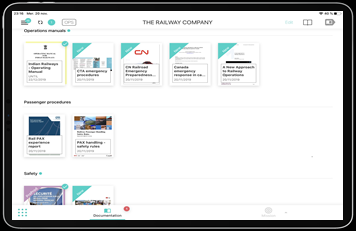
Documentation service: from an iPad, easy access to all documentation and manuals, anywhere, any time
As illustrated below, via innovative services, the Digital Bag can help rail staff better perform their missions, throughout their complete journey:
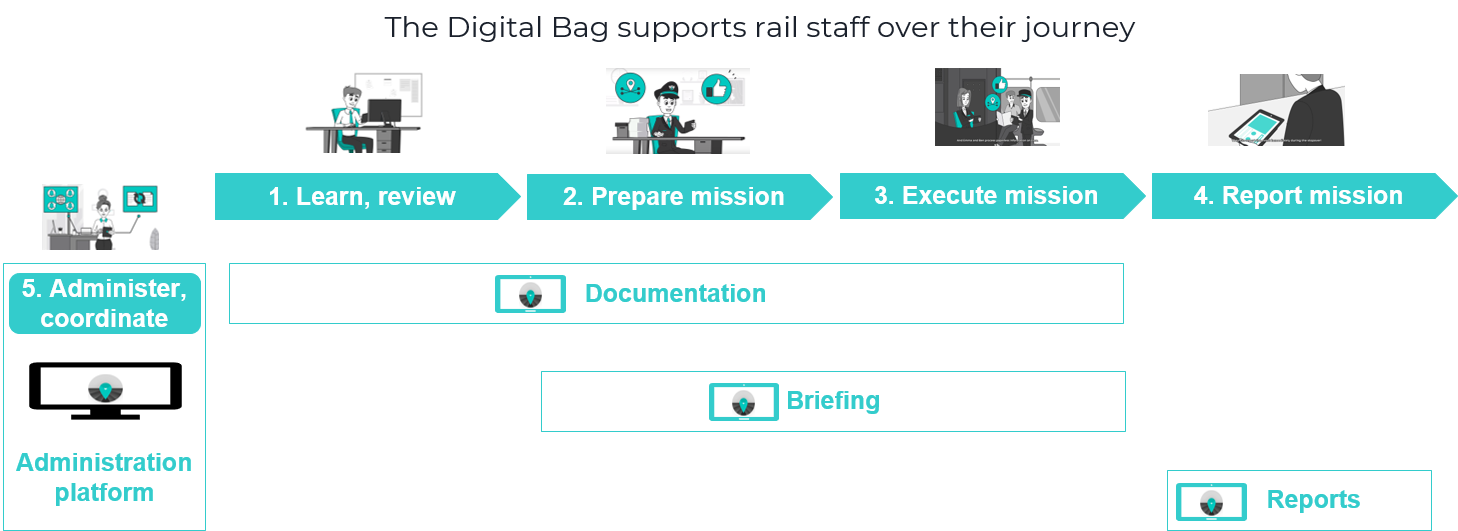
Digital Bag: supports rail staff over their journey
Watch this video to see how the Digital Bag concretely supports rail mobile staff: dgBirds Digital Bag for rail staff
About dgBirds:
dgBirds is a software company based in Paris and is a subsidiary of Air France.
Based on the experience of Air France pilots and cabin crew, dgBirds has developed and proposes a software solution that enables organizations to organise and distribute all the information that mobile staff require during their missions and that they can access from a mobile application.
This value proposition is addressed not only to the air transportation sector but to all transportation organizations that, by definition, have mobile staff who are, on a daily basis, in close relationship with passengers / customers and, as such, are key stakeholders to guarantee the quality of their experience.
contact@dgbirds.com
www.dgbirds.com
The Next Rail Revolution is Here – and the Future is Digital
Jean-Francois spoke about where the rail sector sees itself in a few decades time, and what the endgame of digitalisation could and should be, at the 7th International Railway Summit in Frankfurt
“Digital Railways” doesn’t have quite the romantic ring of the great train services of the past – the Orient Express, the Canadian Pacific or the Trans-Siberian but Digital is the next big wave in the railway sector and train users and operators can look forward to higher service standards ultimately improving efficiency and reliability of railway systems.
A new golden age of rail travel
Railway networks in many countries have become extremely dense, especially on commuter lines in major cities, making it difficult and costly to implement major upgrading projects. Instead, the kind of improvements in efficiency that digital technology excels at can have massive operational impacts.
In fact, digital technologies hold out the promise of true transport integration, linking main-line rail services with other urban transportation modes, enhancing efficiency and passenger convenience. The introduction of Information and Communications Technologies (ICT), Intelligent Transport Systems and open-data/ open-source transport applications are transforming urban transportation, optimising the efficiency of existing and new urban transport systems, at a cost much lower than building new infrastructure from the ground up.
New transport data collection technologies are also being deployed to provide information about delays, downtime and predictive maintenance which could lead to huge improvements in service standards, safety, and unlocking the potential of railways. Passengers will also be able to make real-time decisions about their journeys based on the features that matter most to them such as reliability, safety, travel time and cost. What’s more, railways today offer a connected service all along the passenger journey with on-board wifi for internet and entertainment options.
Other positive aspects of railway digitalization highlighted in a European Railway Review interview include the opportunities digital technology offers for cleaner air as well as the tangible benefits to travelers of increased flexibility and convenience. Enhanced safety, predictive maintenance and automated driverless operation are all part of rail’s future.
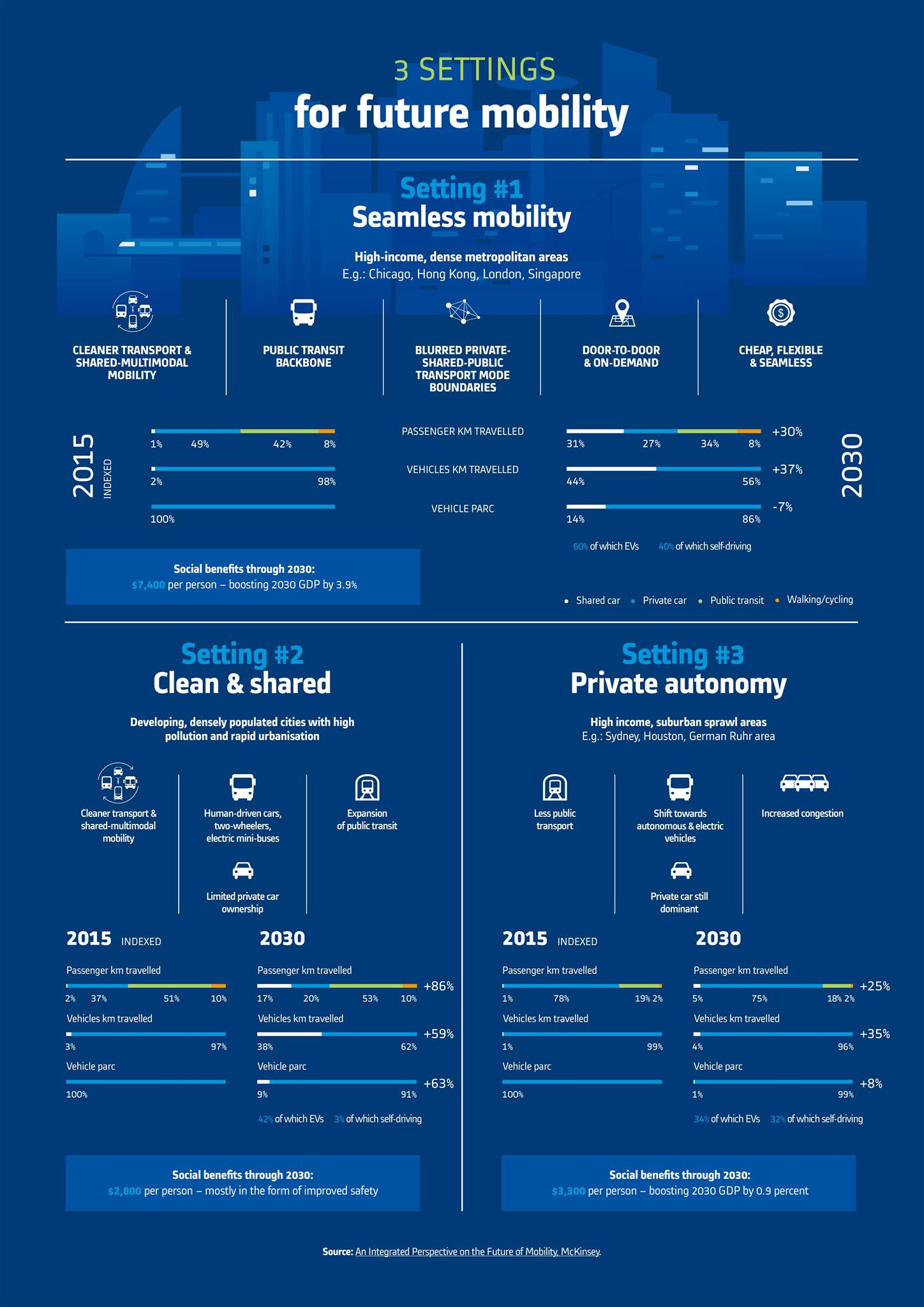
Mastria: Alstom’s multimodal traffic orchestrator. ©Alstom
How do we get there?
The path to digitalisation will not, of course, be entirely smooth. The “Connected trains” survey by management and technology consultancy BearingPoint found that a digitalised and integrated rail system with connected trains is the future, but it will require collaboration and coordination to get there.
Digital technology in the railway sector will see a shift from the traditional emphasis on heavy engineering, to software and data handling skills. There will always be a place for traditional rail engineers, but demand will grow for data management talent, as digital signalling technology unlocks capacity on complex mainline networks.
With new ways of working and new technologies, industry collaboration and effective business change will be more important than ever. Rail operators should take this digitalisation opportunity to integrate different mobility options into their existing offering and consequently focus on value creation through innovation. Without a doubt, it is the quiet efficiency of digital technology that will take rail systems and their passengers into a new age of rail travel that is safer, more convenient and comfortable, more economical, and more climate-friendly.
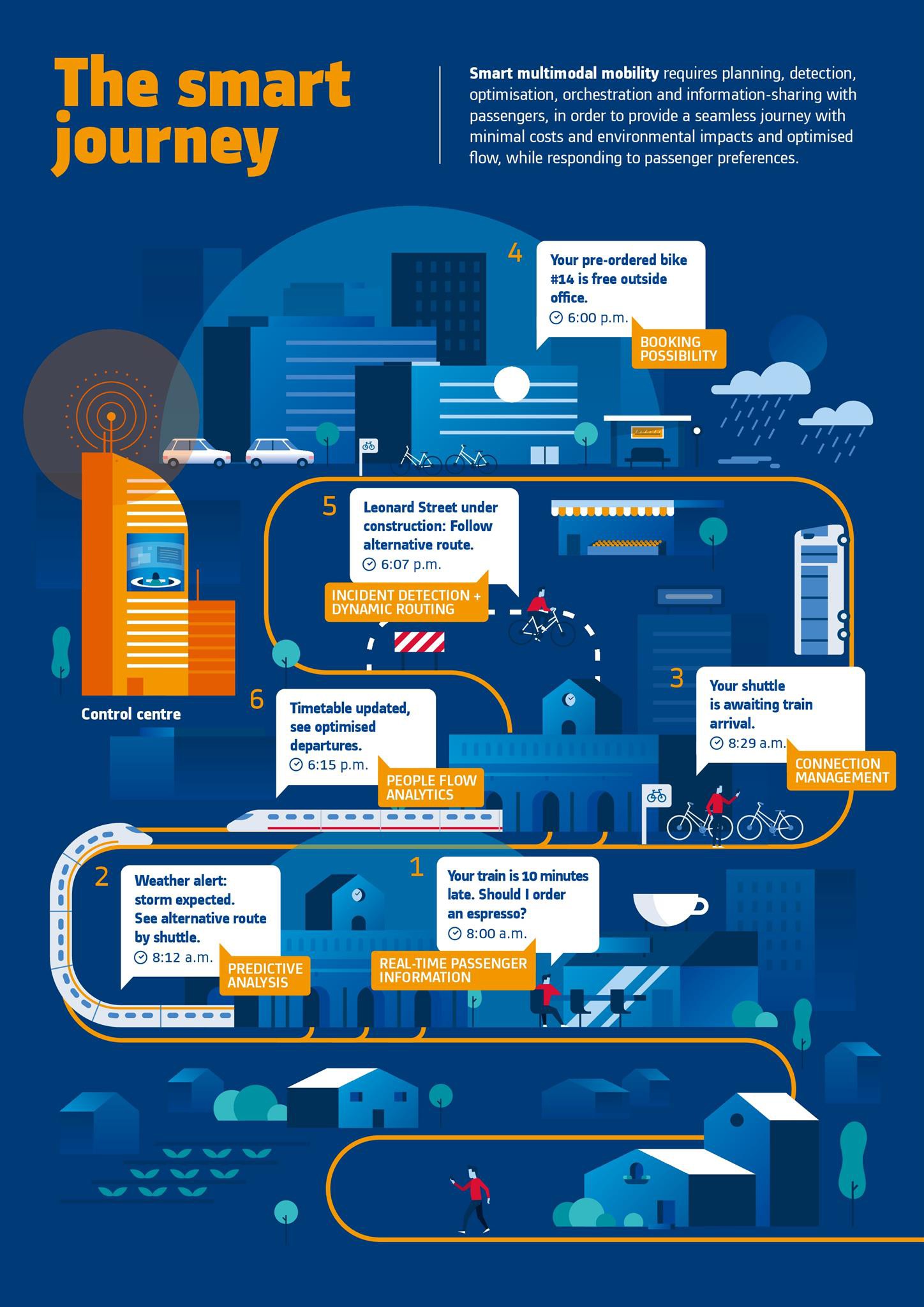
Mastria: Alstom’s multimodal traffic orchestrator. ©Alstom
Making the most of the digital revolution
Jean-Pierre spoke about how rail systems could meet the mobility challenges of the future, about the economic implications of high speed rail, and about whether HSR was delivering on its promise of improving society, at the 4th, 5th, and 6th International Railway Summits respectively.
Jean-Pierre will speak at the 7th International Railway Summit about how digital technologies can enable smooth cross-border travel and trade.
The first thing to note is that rail appears as a key factor in the 21st century world.
Rail is essential but in complementarity, not competition, with other modes, as the backbone of a new mobility chain.
Rail from its origin has survived various revolutions:
- The industrial revolution at the very beginning
- An energy revolution in the 70s
- An information technology revolution in the 80s – 90s
Today, we are now facing the so called 4th revolution: A digital revolution.
This revolution is generating very strong impacts on all decision-making processes, all production and maintenance processes and obviously on the whole information chain itself.
Rail must obviously profit from this technical revolution in order to rapidly and efficiently improve productivity, security and services thanks to connectivity.
One key word is “speed”, since we currently face very strong demands from the markets.
These markets can be intra-urban markets, inter-urban, inter-regional or even inter-continental markets if we consider the emergence of large inter-continental corridors.
Nowadays decision-making cycles are faster and faster. This can be seen as being in contradiction with the operating modes of rail, since investments are really important considering the size of their deployment, and the long cycles of ROI.
These rapid developments obviously demand new approaches and new competencies directly linked to the information domain.
But these have to remain fully compliant with rail technologies and the complexity of its system.
We must admit that, today, the rail sector, whatever the economic context might be, is running out of the resources that would allow the development and the implementation of these new emerging technologies.
Considering this statement, we definitely have to adopt new modes of cooperation.
- Intermodal partnerships have to be enhanced in order to mutualize potential impacts on interfaces, and on shared customers.
- Incubators allow us to work in a different way: Focus on research; Anticipation with the development of Proof of Concepts, demonstrators etc. Innovative funding modes have to be considered as well.
- Links with universities since it is in their hearts and minds, their talents, that the needs of the market, of their market, will be expressed tomorrow. They are the ones who will answer these demands with the emergence of new expertise.
That is the reason why UIC works in close partnership with major actors such as UITP, UNFCC or IATA, why we have developed a Digital platform and an Alliance program with Universities.
Such collaborations enable a better design of our interfaces and the provision of seamless information to our customers, whether Freight or Passenger.
We wish to, and must, open this 19th century pyramid focused on closed working methods and create new circuits open to the outside world, with new partners and relays.
Looking Towards the Future: Shift2Rail at the heart of the Railway Innovation process
Carlo spoke about the key objectives of Shift2Rail at the 4th International Railway Summit, and the digital innovation at its heart during the 5th International Railway Summit in Kuala Lumpur.
Carlo will discuss how operators can make the most of the digital data flood with the use of advanced analytics, as well as the role of transport in Smart Cities, at the 7th International Railway Summit in Frankfurt.
As the first and unique European Railway Research and Innovation (R&I) Programme, the Shift2Rail Joint Undertaking (S2R JU), co-funded through the Union’s Horizon2020 Programme, was pleased to participate in the 4th International Railway Summit. Speaking at the summit, it was essential to highlight how Shift2Rail creates innovative solutions for the railway system.
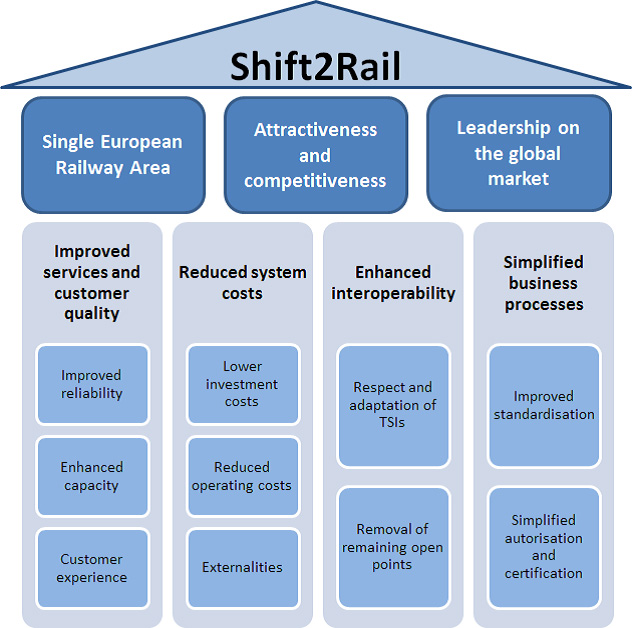
Within the thematic group of EU agencies and bodies supporting EU businesses and innovation, Shift2Rail contributes to smart and sustainable growth through its actions to foster research and innovation in the railway sector. The purpose is to achieve a Single European Railway Area; to enhance the attractiveness and the competitiveness of the European railway system in order to encourage a modal shift from roads towards a more sustainable mode of transport such as rail; and to sustain the leadership of the European rail industry on the global market. These objectives are measured against the following key performance indicators:
- doubling of railway capacity;
- increasing reliability and punctuality by as much as 50% and;
- halving the life-cycle cost of railway
Background
S2R JU was established in 2014 as a public-private partnership in order to increase the investment in research and innovation, and has been fully operational since May 2016. It functions as a platform for the railway sector as a whole to collaborate, coordinate innovation efforts and exchange expertise. It also offers opportunities for SMEs, Research Centres, and Universities to join the R&I activities through its open calls for non-JU members, which comprises at least 30% of the Union’s contribution.
The Founding Members of the Joint Undertaking are the European Union plus eight representatives of the rail industry, including rail equipment manufacturers Alstom, Ansaldo STS, Bombardier, Construcciones y Auxiliar de Ferrocarriles (CAF), Siemens and Thales, along with infrastructure managers Network Rail and Trafikverket. Additional members were selected through an open call with the aim to ensure that railway undertakings and other important public and private stakeholders in the railway sector, as well as actors from outside the sector, are fully represented.
Contribution to Smart and Sustainable Growth
To achieve S2R’s objectives, S2R JU set up five Innovation Programmes (IPs) and a crosscutting package providing the framework for the activities to be implemented. S2R JU provides a new approach to R&I activities with the objective to overcome R&I fragmentation, implement innovative solutions and support their market uptake. Integrated in the S2R R&I Programme is a strong emphasis on demonstration activities and the dissemination of relevant results for market uptake. Railway R&I must address evolving user needs, target cost and efficiency of the Rail Services as well as work towards a more competitive and stronger European Railway industry. Innovation in communication, automation through digitalisation making use of, for example, the rapid developments in artificial intelligence is a necessary step the sector must undertake to deliver a user-centred mobility as a service, for passengers and freight. It should accompany an evolution within the industry towards a new business model boosting its competitiveness and attractiveness.